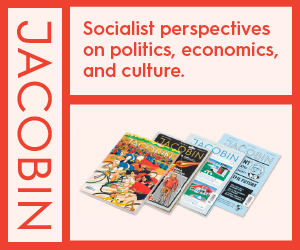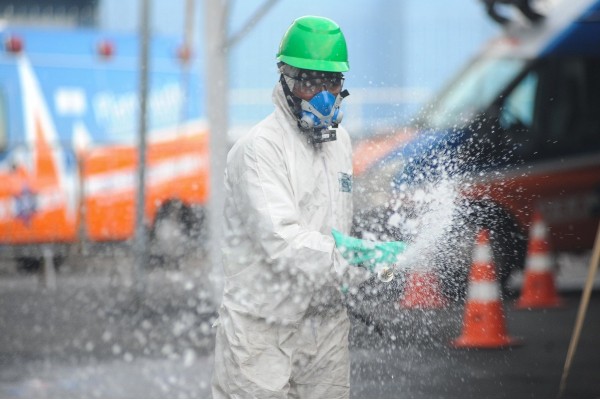The achilles heel of pandemic prevention

“The next pandemic is only a plane ride away,” says Thomas Rowe, a scientific researcher for China’s International Institute of Infection and Immunity. The Toronto SARS outbreak in 2003 fits his comment to a tee, after just one SARS carrier caused an alarming 375 infections and 44 deaths. Luckily, SARS was an epidemic, and not a highly contagious disease. Though Canada was spared a pandemic disaster, the global health community warns that countries face a deadly disease of pandemic proportions in the future.
Despite what the public would like to believe, the unfortunate reality is this: The ability to treat and contain a pandemic is unaided by medical innovation or healthcare workers. Instead, these efforts are undone by just-in-time logistics that place profits and economic “efficiency” ahead of public security.
SARS Revisited
SARS was a wake-up call, and a second chance. The event showed how unprepared and disorganized the health system was, almost running out of essential health supplies, such as N95 masks and hand sanitizer. If stockpiles had been larger and more accessible, perhaps the virus could have been better contained and treated. Additionally, if manufacturers did not rely on just-in-time-methods, they would have been able to produce greater amounts of supplies when needed. “If’s” clearly need to be translated into pragmatic health policies. However, Canada’s pandemic plan has not sought a safer, reliable alternative to the interconnected, just-in-time model that serves business interests, yet neglects the health and welfare of the greater public.
Reason for Alarm
History indicates that a pandemic outbreak is due at any time, though researchers are unable to pinpoint when it will strike. According to the WHO Handbook on Pandemics, influenza pandemics are rare, yet recurring, happening every 10-50 years. In particular, the H5N1 strain of avian flu has sparked action because it has “pandemic potential,” the WHO says. The H5N1 strain of avian influenza first reared its head in Hong Kong 11 years ago. To date, over 250 people have died worldwide, while the virus has steadily moved westward from Asia, and can now be found in parts of the U.K. The virus’ ability to transmit from poultry directly to humans is unnerving. Since influenza viruses morph every year, researchers are keeping a watchful eye on H5N1’s developments.
Thomas Rowe describes the grave Hong Kong outbreak in 1997 as a “pandemic dress rehearsal.” Though it has certainly caused deaths, the disease is not highly transmissible and infectious – yet. “In order for a pandemic to be considered as such, there are three requirements. One: The virus must have a ‘novel’ makeup, two: there is little or no pre-existing immunity in the human population, and three: the virus must be easily transmitted from human to human. Right now, H5N1 doesn’t fulfill the last requirement.”
On the brink of a disease outbreak, the World Health Organization recommended that nations formulate pandemic plans. While developing countries struggle to scrape together enough funds to purchase essential anti-viral vaccines, Canada is held back by its efficient supply chain system.
“In the Nick of Time” is Risky Business
The emergence of the just-in-time supply chain has generally yielded profitable results for businesses; however corporate earnings are not the be-all and end-all when public health is on the line. Ideally, both the economy and healthcare system can be sustained if pandemic supplies are manufactured and stockpiled locally, avoiding the just-in-time system entirely.
Professor Edward Comor defines the just-in-time system as: “A business buzzword for minimizing inventory costs by producing and distributing goods only when customers ask for it.” Since people will likely seek treatment sooner or later, just-in-time principles are ill-suited for these “customers.” The federal government has issued a quota for their anti-viral stockpile – an objective to cover 25% of the Canadian population. Whether or not this painfully small stockpile will even be accessible during a pandemic is questionable and unlikely, as antivirals are stored in certain hubs located across the country. However, the once simple task of sending and receiving goods essential disintegrates in a pandemic crisis.
Under normal conditions, the shipment process would flow smoothly – from the manufacturer, to the hospitals and to the local health units. Whenever their supplies are running low, health centres order and receive what they need, in the nick of time.
Dr. Bhagirath Singh, the scientific director of the Institute of Infection and Immunity, of the Canadian Institute of Health Research, describes this process: “Hospitals keep the adequate amount of supplies they require, depending on certain diseases, and their incidence during certain periods of the year. There is a minimum on-hand supply, sufficient for day-to-day use.” He goes on to say that as a public health measure, emergency supplies are generally stored in separate hubs, and that “emergency supplies can be shipped when needed.” However, assuming vaccines and other supplies can be transported efficiently presumes that work, business and trade will carry on as usual – a very large assumption.
A Catch 22
During the immediate onset of a pandemic, containment is critical. “The WHO estimates that it will take three months for a pandemic to spread across the globe,” says Dr. Singh. With so little time, taking preventative measures is especially important. The WHO Handbook recommends social distancing and limited transportation. Schools and workplaces will be forced to shut down. People and goods will cease to move in and out of their local area, while infected persons will either be quarantined or self-isolated.
Import and export goods will suffer greatly with no means to produce, distribute, and sell, equating to a strained Canadian economy. According to The Canadian Intelligence Agency’s World Factbook analysis, Canada relies heavily on selling export commodities, accounting for $433.1 billion dollars in 2007. The service industry accounts for the most employment – 76% of labour, while manufacturing is second, making up 13%. Utilizing just-in-time methods throughout key industrial sectors such as these, the infrastructure will collapse with no “bodies” to produce and distribute the essential goods that can help the public stay healthy.
It’s a catch 22: These containment measures will limit health workers’ ability to prevent and treat the imminent virus if people aren’t able to perform their capitalist duties to produce and consume. If health supplies were stockpiled locally, rather than situated in distant hubs across the country, there wouldn’t be this catch to pandemic prevention.
Wanted: A Community Response
With federal and provincial stockpiles of emergency supplies waiting to be deployed in distant locations, how will local health units attain more goods when work and transport have stopped? The brunt of the responsibility will lie with local community groups, family physicians and local health units. Patricia Simone, the manager of Emergency Preparedness at the Middlesex-London Health Unit in Ontario, describes the province’s mandate to distribute vaccines, should normal shipping logistics break. “The plan calls for flu assessment centres, or triage centres to be set up locally. These areas would distribute antiviral medications.” She goes on to add, “The government has not said where the responsibility lies right now, but it’s generally understood that communities, hospitals and health units should step up.”
Similarly, researcher Thomas Rowe stresses the importance of coordinating the private and public sectors. “Efforts have to be coordinated between the government, private groups and the public system. We have to find community groups that will distribute vaccines – schools and churches –which will fuse both interests at a local level.”
Though a “community response,” as Dr. Singh calls it, would improve matters in theory, these efforts will likely be undermined when there are supply shortages. Ultimately, communities are at the mercy of health manufacturers and government officials, who give the green light to send shipments to areas in need. With a relatively small antiviral stockpile – totalling only 25% of the Canadian population – prioritizing certain groups will be an unfortunate necessity.
“The fact is that there is a priority for certain people. Front line health workers who treat the sick will receive the first preventative treatments,” says Dr. Singh. “It’s certainly an ethical issue.” Evidently, this debate has been so controversial that the federal government has responded with silence, refraining from formulating a priority list to guide local units in the right direction.
Manufacturing Power
Roche Pharma, the sole global developer of antiviral treatment, Tamiflu, prohibits individuals from purchasing the drug over the counter. Since Tamiflu requires a prescription, stockpiling the antiviral prior to onset of sickness is not an option. Dr. Singh looks positively on the limits placed on this medication: “Individuals stockpiling antivirals develop a false sense of security,” he says.
“Ultimately, this does little to ensure that the whole community has access to these already limited treatments.” Though treatments are “available,” this does not mean the public can take preventative measures with antiviral stockpiles of their own. Instead, responsibility falls on the shoulders of the state to adequately distribute materials. Dr. Singh views Roche Pharma’s policy as necessary and even altruistic; however, this argument does not take logistics into account. “The whole community” will clearly have difficulties accessing products with the current distribution model that relies on efficient transportation and labourers that will be in low supply during a pandemic. In effect, the government cannot wholly ensure that people will receive antiviral treatment, though the state bears all the responsibility to provide such drugs if need be. Is that not a false sense of security?
The only form of power the general public has is from an educational standpoint. Patricia Simone mentions, “It’s about protecting yourself against the flu – using sanitizers, covering your mouth and washing your hands that will be important. There won’t be too many other supplies available to the public.”
Thomas Rowe emphasizes that people should refrain from working if they feel unwell. “If people are sick when they go to work, then they will only spread the disease. Education is key for the population, because once there’s a pandemic, it’s going to be difficult to get anything done.”
Rethinking the Supply Chain
Although a staple characteristic of modern and successful economies, the highly interconnected supply chain is a “thorn in the side” for effective pandemic preparedness. If health supplies are stockpiled directly at the source - where communities will indefinitely need them, then the dangers of the just-in-time supply chain will be avoided. Particularly, manufacturers should have no excuse for not manufacturing larger quantities of products with an unlimited shelf life. If the global health community is correct in predicting a serious pandemic outbreak, companies will not need to worry about having profitable returns, as these supplies will be in high demand. Guaranteed.
Professor Comor points to a neo-keynesian form of politics that may help subvert the shortcomings of just-in-time systems. The economic and political norms of the post-World War II era was marked by increased market regulation by the state, minimizing the chance of economic crises. Though there are challenges to
Altering the production and distribution of key health products will certainly improve access to supplies, though this is a relatively small step in correcting greater economic policies and rethinking engrained neo-liberal ideologies. As a whole, the predominant just-in-time supply chain puts the population in harm’s way. As Professor Comor states, the 1980s were marked by the introduction of neo-liberal policies that support corporate initiatives. The current neo-liberal era is market-oriented, placing precedence with profits and short-term, “logical thinking.”
“Just-in-time reflects and extends our modern society’s short-term thinking on a whole range of issues. Certainly neo-liberalism deepened this general neglect of history and the long term,” says Professor Comor. Therefore, planning for a pandemic outbreak is an event neo-liberal societies are ill-equipped to handle – logistically and ideologically.
Just-in-time methods seem to make sense for the government, and the corporations that keep the economy healthy and stable. However, one must question how “healthy” and “stable” the system is in actuality, when our so-called economic efficiency is rendered ineffective during a pandemic outbreak.
For More Information:
The World Health Organization’s Epidemic and Pandemic Alert Response
The World Health Organization’s Handbook on Influenza Pandemics
Ontario Health Plan for an Influenza Pandemic – see Chapter 9 on Accessing Antivirals & Vaccines
Emily Hiltz is an instructor and faculty co-op advisor at Carleton University’s School of Journalism and Communication.










